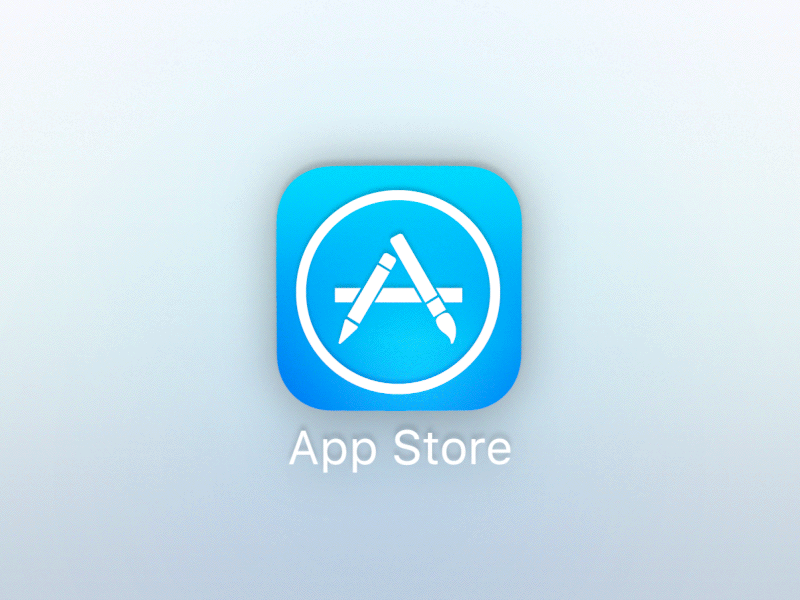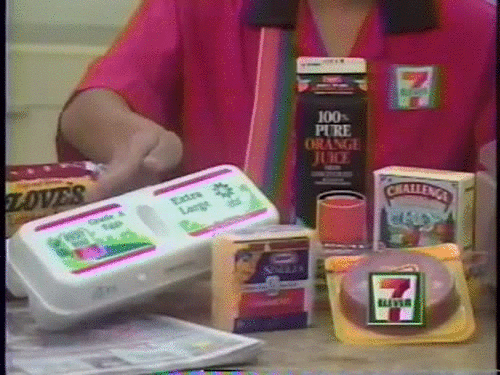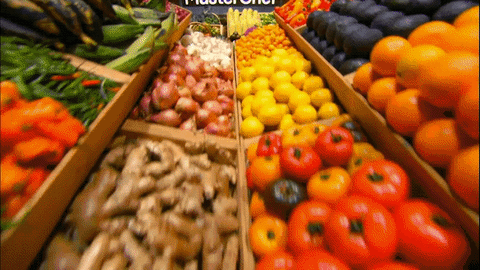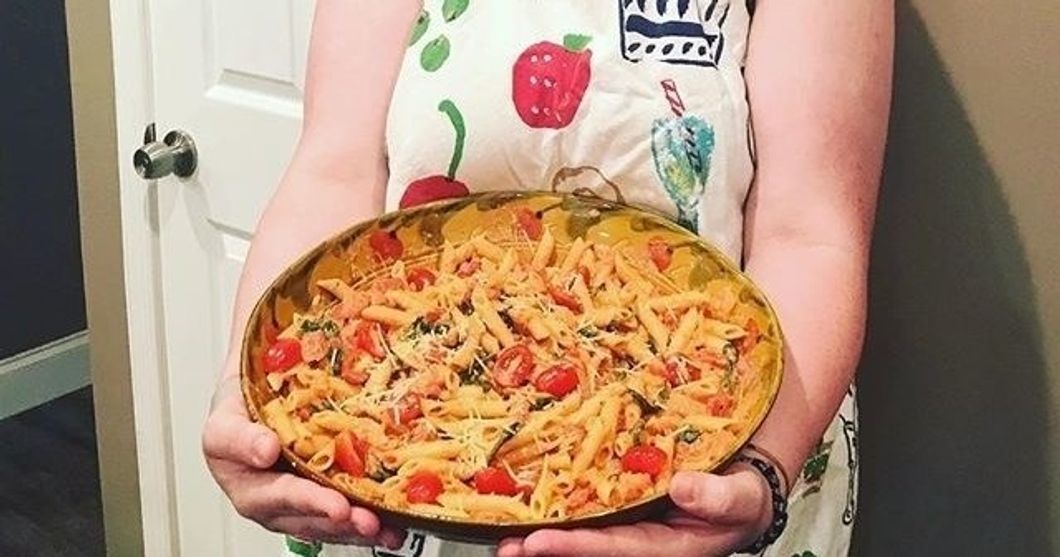In my previous years of school, I have always had a full meal plan. It served me well, and all I really ever had in my dorm were snacks and coffee. But as a new apartment dweller, I have found it's okay not having a full plan. Sure, I still have a mini-plan that lets me get some food while I'm on campus, but for the most part, the food's done by me.
Here is how I have figured out how to budget my food money wisely and cut costs, so I can still eat three meals a day and still have money left over at the end of the week. Oh, AND I'm helping the environment along the way.
1. Download grocery store apps.

Find all the grocery stores in whatever radius you are comfortable with. If you don't have a car, find the ones in walking distance or close to transit stops. If you have a car, figure out how far you want to drive for food. Most commercial chains will have an app; download them.
Sure, your friends might call you a mom, but the apps will give you a digital copy of the store circular, so you can see where the best deals on essentials like produce, dairy, meat, and bulk goods are. An even bigger bonus is if the app has special online coupons just for people who use the app.
Figure out who has the best deals on what and write them down so you don't forget.
2. Become a loyalty member EVERYWHERE.

A lot of those deals you find in the weekly circulars and coupons on the store apps can only be acknowledged if you have a loyalty card. I know what you're thinking: "But Anne, I don't want to lug around 15 store cards in my wallet or on my keys."
BUT WAIT! That's not an excuse! 99% of stores can just use your telephone number to look you up, and you still get all those sweet, sweet deals.
Stores want you to sign up for these cards because they keep track of what populations are buying and can adjust the prices regularly to get you the deals. Why is product tracking good? If a store tracks your frequent purchases and offers individualized coupons, you'll get coupons for those items!
Reminder: a loyalty card is not the same thing as a credit card. Generally, store credit cards aren't the best value in the long run, so I advise you to stay away from them.
3. Know what's in season.

Produce that is in season is going to be cheaper. Why? Because less money is being put into shipping costs from a climate where it IS in season (generally South America), and local farmers from your area can ship it right down the street. Find out if there are regional crops that are local to you and try including them in planning.
I also highly recommend looking for farmer's markets in your local communities. It cuts out the middleman, and it cuts down on emissions. You support a local business, help the environment, and get delicious, low-pesticide or organic food. Win/win for everyone.
If you want more resources on what's in season, check out this website.
4. Shop for meat when it's on sale.

Generally speaking, one or two cuts of meat go on sale each week. It could be on sale for many reasons, some including they received too much of it from suppliers, or a large amount of their stock will expire within a week. If you eat meat, look on your apps or in the circulars for what cuts of meat are on sale and plan from there.
There is no point in buying a pack of chicken breasts that are $3.50 a pound when it's going to go on sale next week for $1.50 a pound.
If you like a certain cut or type of meat, buy multiple packages and freeze it. Un-ground meats can stay frozen for up to a year. Just remember to factor in what you have already when making your grocery lists.
If you have frozen meat that you want to use, be sure to follow proper safety procedures when defrosting it for use. No one likes being sick, especially when it's preventable.
5. Shop for multi-use ingredients.

Shop for ingredients you can make more than one meal out of. That way, you utilize your ingredients, so that you can get multiple uses out of them for the week. Bonus points if you can get multiple meals out of one ingredient!
A good example for me is the humble rotisserie chicken from the deli section.
On Sunday night, I ate chicken with rice and broccoli. But I can't eat a whole chicken, so I picked all the meat off of the bones. I then boiled the bones in water with garlic for an hour and a half and made my own chicken stock.
On Monday, I used some of my leftover chicken meat and made myself a big chicken sandwich for lunch. For dinner, I added celery, carrots, onions, my leftover chicken meat, and egg noodles to my homemade chicken stock and made chicken soup.
I not only have leftover chicken for more sandwiches (which I can make hot or cold), but I also have soup which stays good for around a week.
I have made multiple meals out of one ingredient and pantry staples. I already had the vegetables for the soup and bread for sandwiches; all I needed was the chicken itself and a bag of noodles.
Other multi-use ingredients include large boxes of pasta, potatoes, canned tuna, and sliced cheese.
6. Plan your meals ahead of time.

Always plan your meals BEFORE you get to the store, or you'll always forget a key ingredient. The internet has TONS of websites and resources for recipes and meal planning, so you'll never be without. Not a great cook? Look for low ingredients or easy meals. Don't know how to use the stove top? Look for meals made on a sheet pan in the oven.
Think you're going to burn down your place? Invest in a crockpot and dump all the ingredients in it. Plug it into a surge protector for added reassurance that you will not kill anyone by making dinner and still have it taste good.
When planning meals, always be sure to look at what you already have in your pantry, fridge, and freezer, as well as making a note of what's about to expire.
If your vegetables are looking a little wilted, make a soup. If your bananas are browning, make some banana bread or freeze them for breakfast smoothies.
By doing this, you are not only saving money by utilizing what you have but are also helping the planet with the all-too-real problem of food waste!
7. Make your own coffee or tea.

I love Starbucks just as much as or more than the next guy, but it quickly adds up. When I had a job as a preschool teacher, I often bought my coffee every morning. That, along with whatever breakfast item I was eating, always ended up costing somewhere around five to 10 dollars a day.
I have a Keurig, but I have been trying to use a french press more so that I can cut down on plastic waste. I have found multiple recipes on websites like Pinterest that teach you how to make your fancy beverages at a fraction of the cost. Many of the teas found at Starbucks are also sold in stores, making it easy to recreate the drink; and most grocery and big-box stores carry different types of syrups for you to experiment with.
Even with a meal plan, those dollars quickly add up when you could be spending them on full meals. Coffee is pennies to the ounce, and so are milk and sugar. Save your money here and get to treat yourself somewhere else.
Note: when buying coffee, check if it's Fair Trade Certified. The coffee industry is notorious for exploitation. If it's possible, check out local roasters and be sure to inquire how they get their beans and their source's business practices.
8. Realize convenience meals are just that: convenient.

Convenience meals are the meals you buy next to the pasta and rice that just require hot water or are frozen, microwavable meals. While they seem like a quick and easy way to eat, often the price per serving of these meals is way higher than if you made whatever item it is by yourself. An 18-pack of Easy Mac is $11.30, but the price of macaroni, cheese, milk, and butter is way lower, and you probably already have milk and butter.
While they're an easy pick, they often are full of unneeded preservatives and ingredients and are wrapped in lots of bulky, non-recyclable packaging. Do yourself a favor and just find an easy recipe for your favorite foods.
9. Fill your pantry with staples.

The easiest way to eat on a budget is to make sure you always have pantry staples. Staples help you make food on the fly and generally don't break the bank. Make sure you always have carrots, celery, onions, garlic, and potatoes. Fill your pantry with rice, beans, and pasta when they go on sale (there truly isn't a big difference when it comes to store brands and name brands, so just get the cheaper one). Buy cans of tomatoes, which can easily be made into sauce.
Most importantly, always make sure you have butter or margarine and bread. You will never go hungry with a well-stocked pantry.
10. Recognize you can have a treat.

You work hard, and if you're budgeting your food wisely, you know it takes a lot of time. But think about all of the hard work this way: you now can reward yourself with going out to dinner a little more often. The easiest thing to do when planning to go out on a budget is to know your deals. Most restaurants, especially in college towns, have deals or specials certain days of the week.
Know which days will give you the best deal and give yourself a treat. You deserve it!
The art of budgeting and meal planning does not come easily. It requires you to evaluate every purchase you make and to think about the multiple uses each ingredient can be used for. Cooking, especially if you have never done it before, can be overwhelming. The best thing to do is dip your feet in first before jumping in. Start with easy meals and progress until you are comfortable.
















